CHEVROLET CAMARO 1994 4.G Owners Manual
Manufacturer: CHEVROLET, Model Year: 1994, Model line: CAMARO, Model: CHEVROLET CAMARO 1994 4.GPages: 292, PDF Size: 15.35 MB
Page 121 of 292
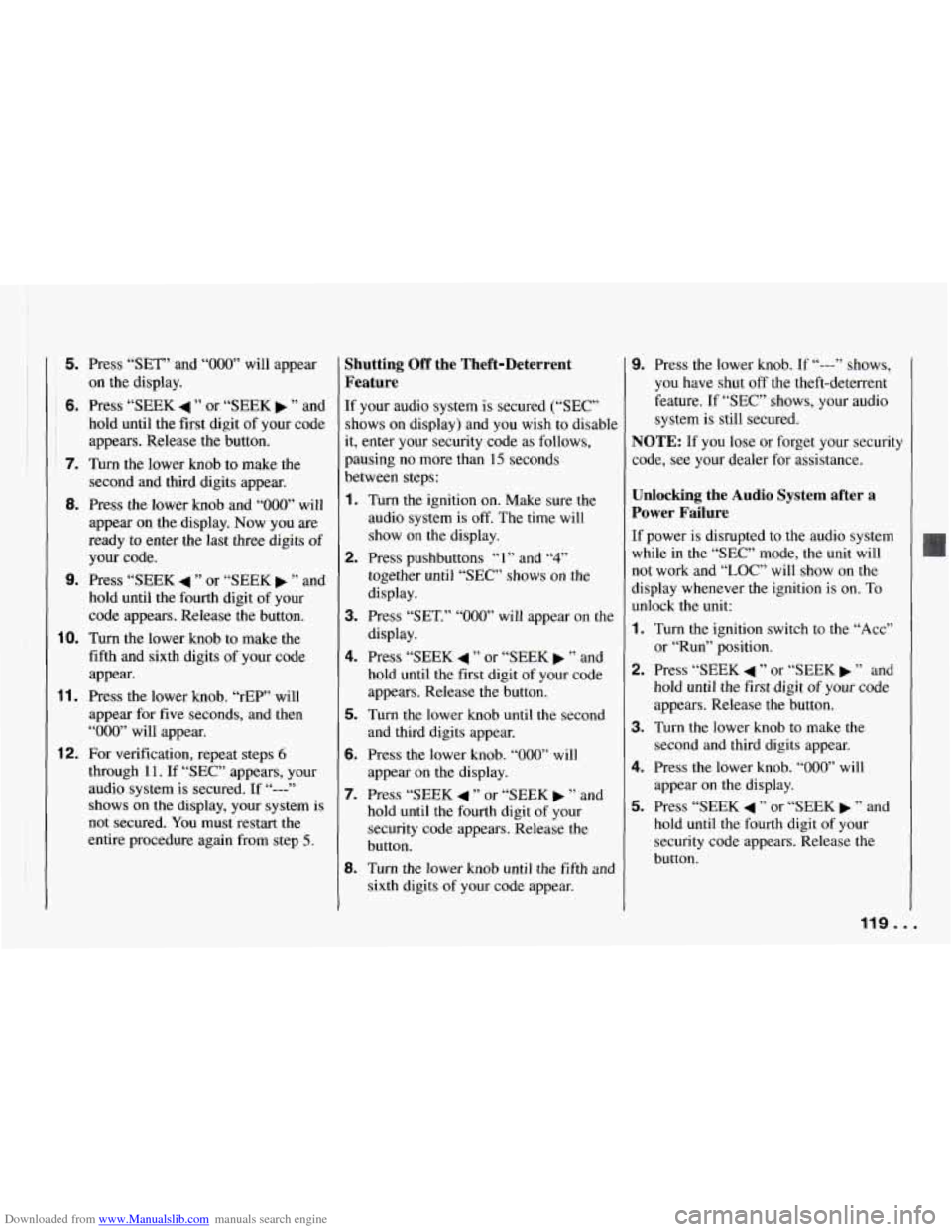
Downloaded from www.Manualslib.com manuals search engine 5. Press “SET” and “000” will appear
on the display.
~ 6. Press “SEEK 4 ” or “SEEK b ” and
hold until the first digit of your code
appears. Release the button.
7. Turn the lower knob to make the
second and third digits appear.
8. Press the lower knob and “000” will
appear on the display. Now you are
ready
to enter the last three digits of
your code.
9. Press “SEEK 4 ” or “SEEK b ” and
hold until the fourth digit of your
code appears. Release the button.
10. Turn the lower knob to make the
fifth and sixth digits of your code
appear.
11. Press the lower knob. “rEP” will
appear for five seconds, and then
“000” will appear.
through
11. If “SEC” appears, your
audio system is secured.
If “---”
shows on the display, your system is
not secured.
You must restart the
entire procedure again from step
5.
12. For verification, repeat steps 6
Shutting Off the Theft-Deterrent
Feature
If your audio system is secured (“SEC”
shows on display) and you wish to disable
it, enter your security code as follows,
pausing no more than
15 seconds
between steps:
1. Turn the ignition on. Make sure the
audio system is
off. The time will
show on the display.
together
until “SEC” shows on the
display.
3. Press “SET.” “000” will appear on the
display.
4. Press “SEEK 4 ” or “SEEK b ” and
hold until the first digit of your code
appears. Release the button.
5. Turn the lower knob until the second
and third digits appear.
6. Press the lower knob. “000” will
appear on the display.
7. Press “SEEK 4 ” or “SEEK b ” and
hold until the fourth digit of your
security code appears. Release the
button.
8. Turn the lower knob until the fifth and
2. Press pushbuttons “1” and “4”
sixth digits of your code appear.
9. Press the lower knob. If “---” shows,
you have shut off the theft-deterrent
feature. If
“SEC” shows, your audio
system is still secured.
NOTE: If you lose or forget your security
code, see your dealer for assistance.
Unlocking the Audio System after a
Power Failure
If power is disrupted to the audio system
while
in the “SEC” mode, the unit will
not work and “LOC”
will show on the
display whenever the ignition is on. To
unlock the unit:
1. Turn the ignition switch to the “Acc”
or “Run” position.
2. Press “SEEK 4 ” or “SEEK b ” and
hold until the first digit of your code
appears. Release the button.
3. Turn the lower knob to make the
second and third digits appear.
4. Press the lower knob. “000” will
appear on the display.
5. Press “SEEK 4 ” or “SEEK b ” and
hold until the
fourth digit of your
security code appears. Release the
button.
119.. .
Page 122 of 292
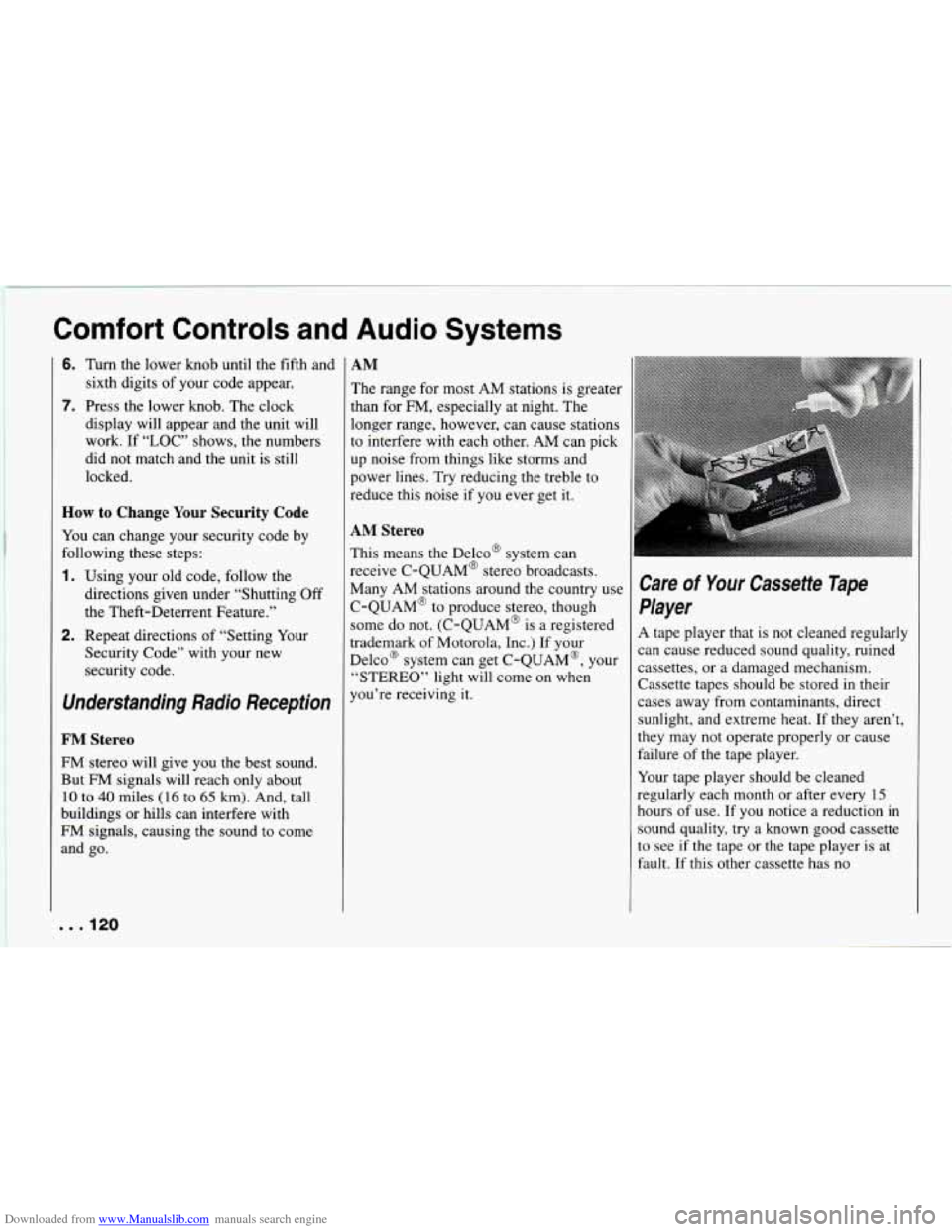
Downloaded from www.Manualslib.com manuals search engine Comfort Controls and Audio Systems
6. Turn the lower knob until the fifth and
sixth digits
of your code appear,
7. Press the lower knob. The clock
display will appear and the unit will
work. If
“LOC” shows, the numbers
did not match and the unit is still
locked.
How to Change Your Security Code
You can change your security code by
following these steps:
1. Using your old code, follow the
directions given under “Shutting
Off
the Theft-Deterrent Feature.”
2. Repeat directions of “Setting Your
Security Code” with your new
security code.
Understanding Radio Reception
FM Stereo
FM stereo will give you the best sound.
But
FM signals will reach only about
10 to 40 miles (16 to 65 km). And, tall
buildings or hills can interfere with
FM signals, causing the sound to come
and go.
I
AM
The range for most AM stations is greater
than for
FM, especially at night. The
longer range, however, can cause stations
to interfere with each other. AM can pick
up noise from things like storms and
power lines. Try reducing the treble to
reduce this noise if you ever get it.
AM Stereo
This means the Delco@ system can
receive C-QUAM@ stereo broadcasts.
Many
AM stations around the country use
C-QUAM@ to produce stereo, though
some do not. (C-QUAM@
is a registered
trademark of Motorola, Inc.) If your
Delco@ system can get C-QUAM@, your
“STEREO” light will come on when
you’re receiving it.
Care of Your Cassette Tape
Player
A tape player that is not cleaned regularly
can cause reduced sound quality, ruined
cassettes, or a damaged mechanism.
Cassette tapes should be stored in their
cases away from contaminants, direct
sunlight, and extreme heat. If they aren’t,
they may not operate properly or cause
failure of the tape player.
Your tape player should
be cleaned
regularly each month or after every
15
hours of use. If you notice a reduction in
sound quality, try a known good cassette
to see if the tape or the tape player
is at
fault. If this other cassette has no
. . .I20
Page 123 of 292
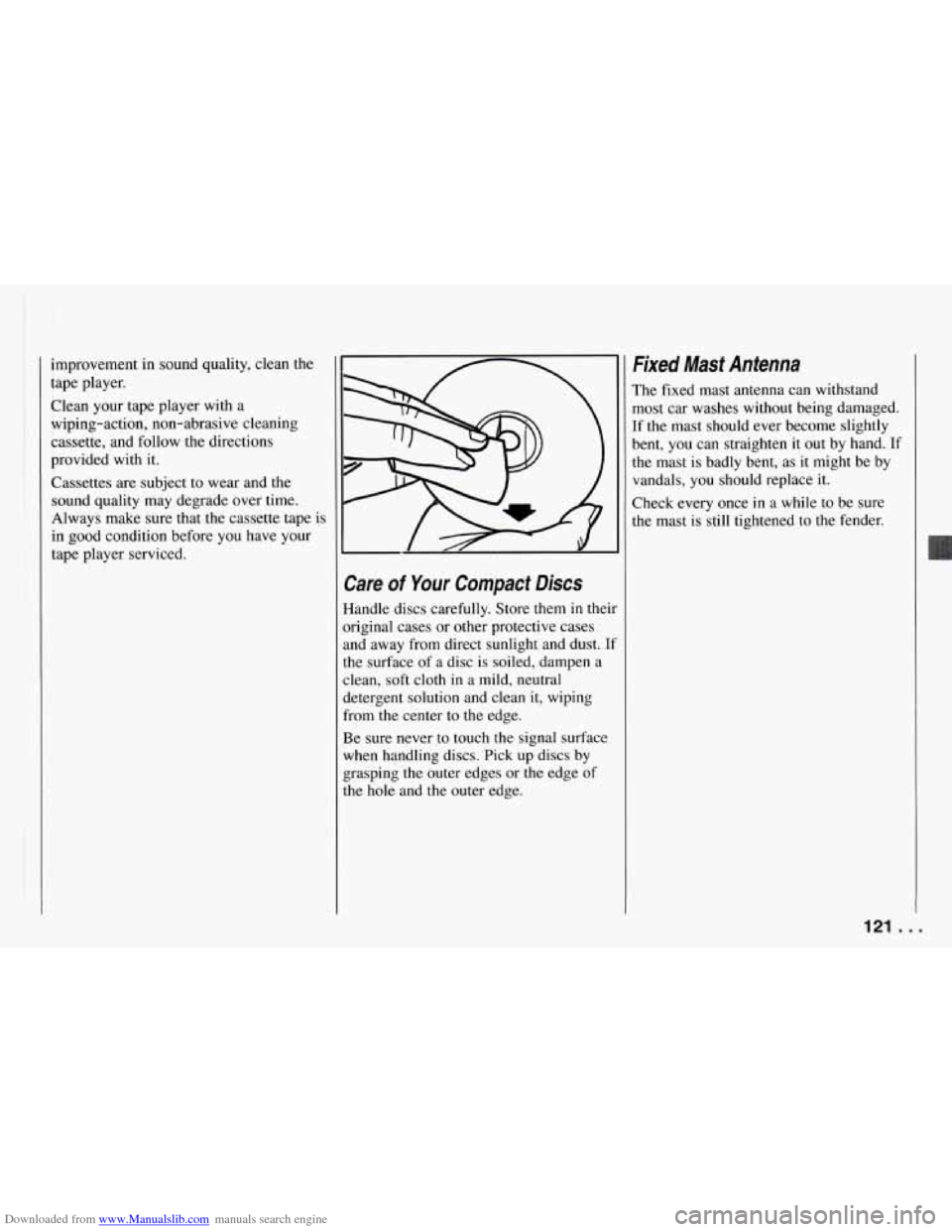
Downloaded from www.Manualslib.com manuals search engine improvement in sound quality, clean the
tape player.
Clean your tape player with a
wiping-action, non-abrasive cleaning
cassette, and follow the directions
provided with it.
Cassettes are subject to wear and the
sound quality may degrade over time.
Always make sure that the cassette tape is
in good condition before you have your
tape player serviced. Fixed Mast Antenna
The fixed mast antenna can withstand
most car washes without being damaged.
If the mast should ever become slightly
bent, you can straighten it out by hand. If
the mast is badly bent, as it might be by
vandals, you should replace
it.
Check every once in a while to be sure
the mast is still tightened to the fender.
Care of Your Compact Discs
Handle discs carefully. Store them in theil
original cases or other protective cases
and away from direct sunlight and dust.
U
the surface of a disc is soiled, dampen a
clean, soft cloth in a mild, neutral
detergent solution and clean
it, wiping
from the center to the edge.
Be sure never
to touch the signal surface
when handling discs. Pick up discs by
grasping the outer edges or the edge
of
the hole and the outer edge.
121 .I
Page 124 of 292
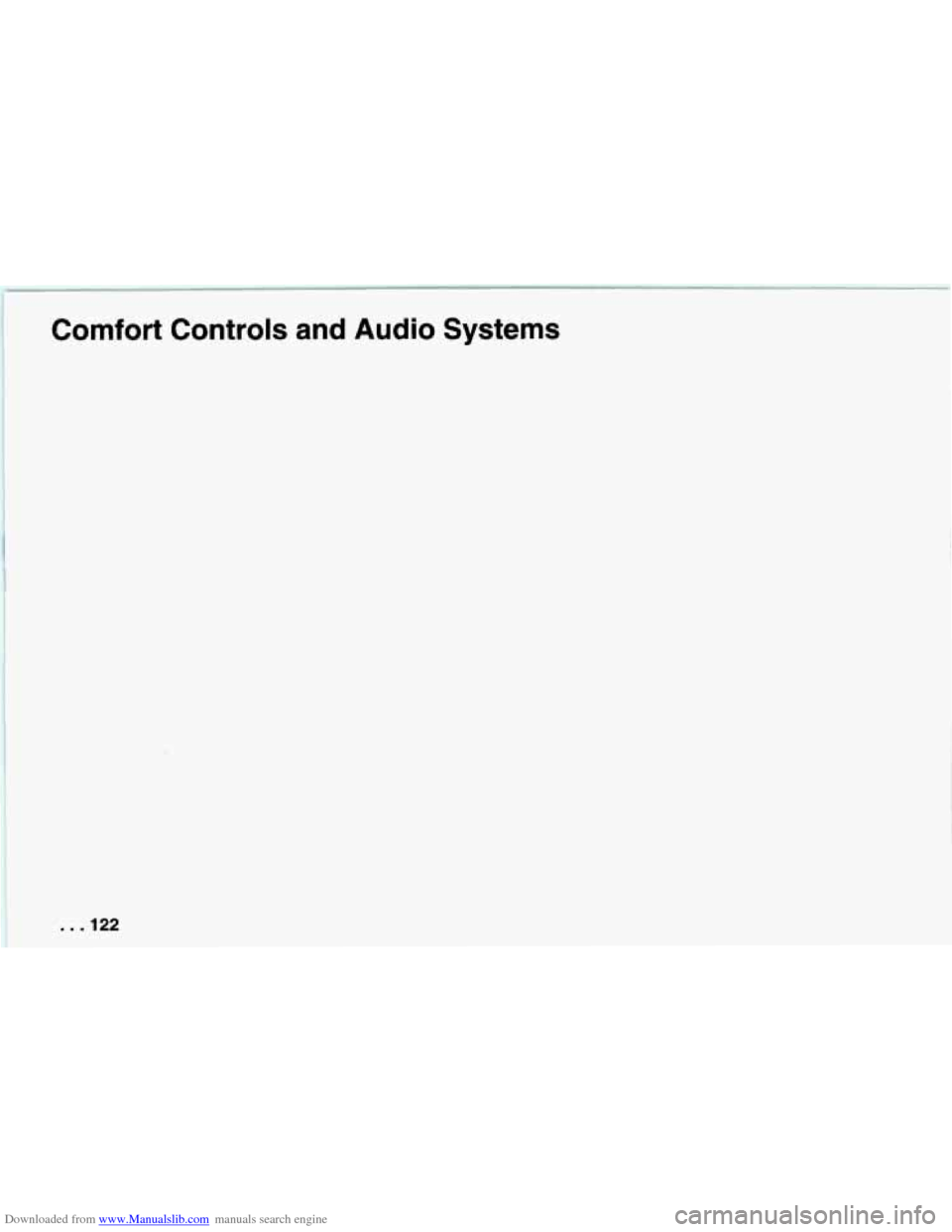
Downloaded from www.Manualslib.com manuals search engine Comfort Controls and Audio Systems
. . .I22
Page 125 of 292
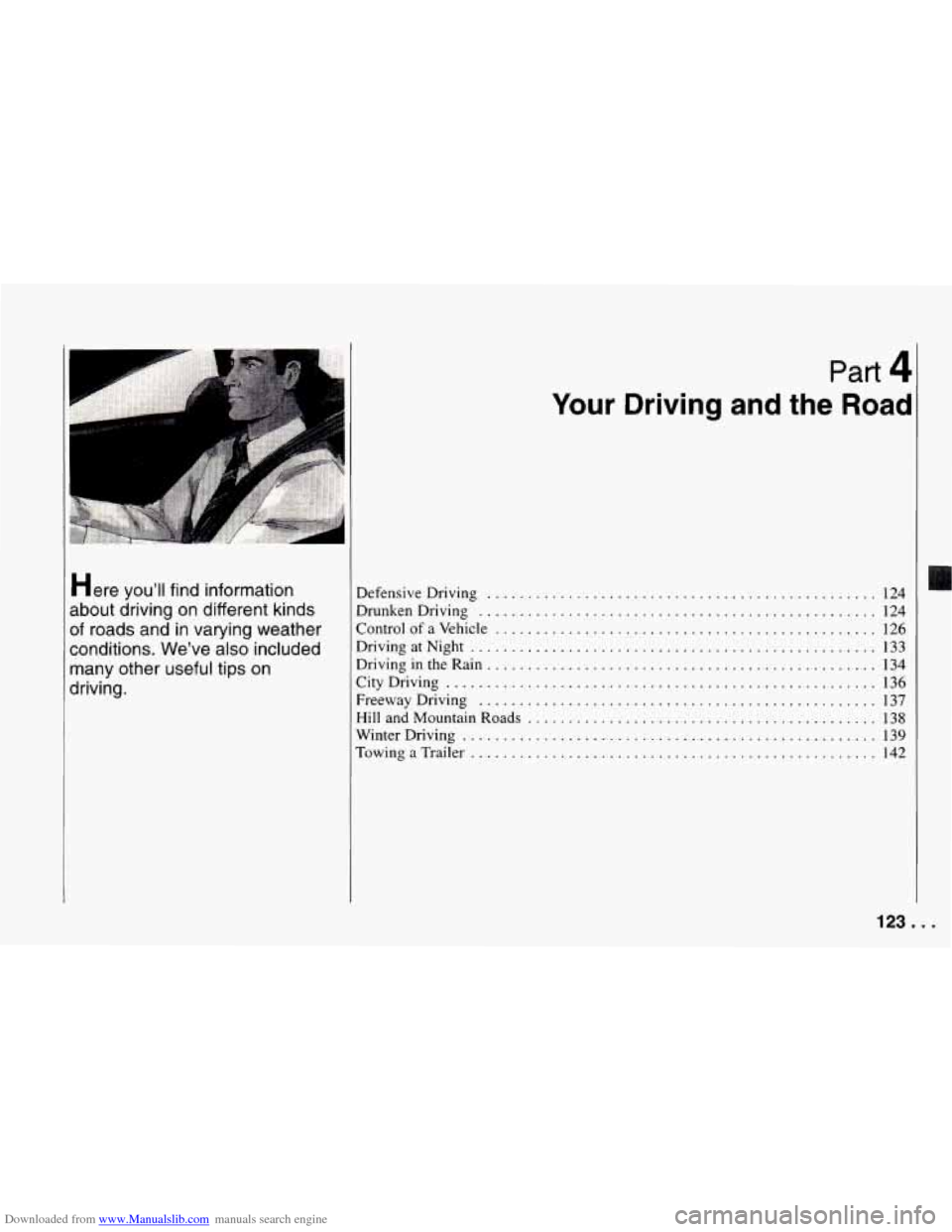
Downloaded from www.Manualslib.com manuals search engine Part 4
Here you’ll find information
about driving on different kinds of roads and in varying weather
conditions. We’ve also included
many other useful tips on
driving.
I
I
I
Your Driving and the Road
DefensiveDriving ................................................ 124
DrunkenDriving
................................................. 124
Control
of a Vehicle , . . . . . . . . . . . . . . . . . . . . . . . . . . . . - . . . . . . . . . . . . . . . . . 126
DrivingatNight
.................................................. 133
Driving in the Rain
. . . . . . . . . . . . . . . . . . . . . . . . . . . . . . . . . . . . . . . . . . . . . . . . 134
CityDriving
..................................................... 136
FreewayDriving
................................................. 137
Hill and Mountain Roads . . . . . . . . . . . . . . . . . . . . . . . . .
. . . . . . . . . . . . . . . . . . 138
WinterDriving
................................................... 139
TowingaTrailer
.................................................. 142
123 ...
Page 126 of 292
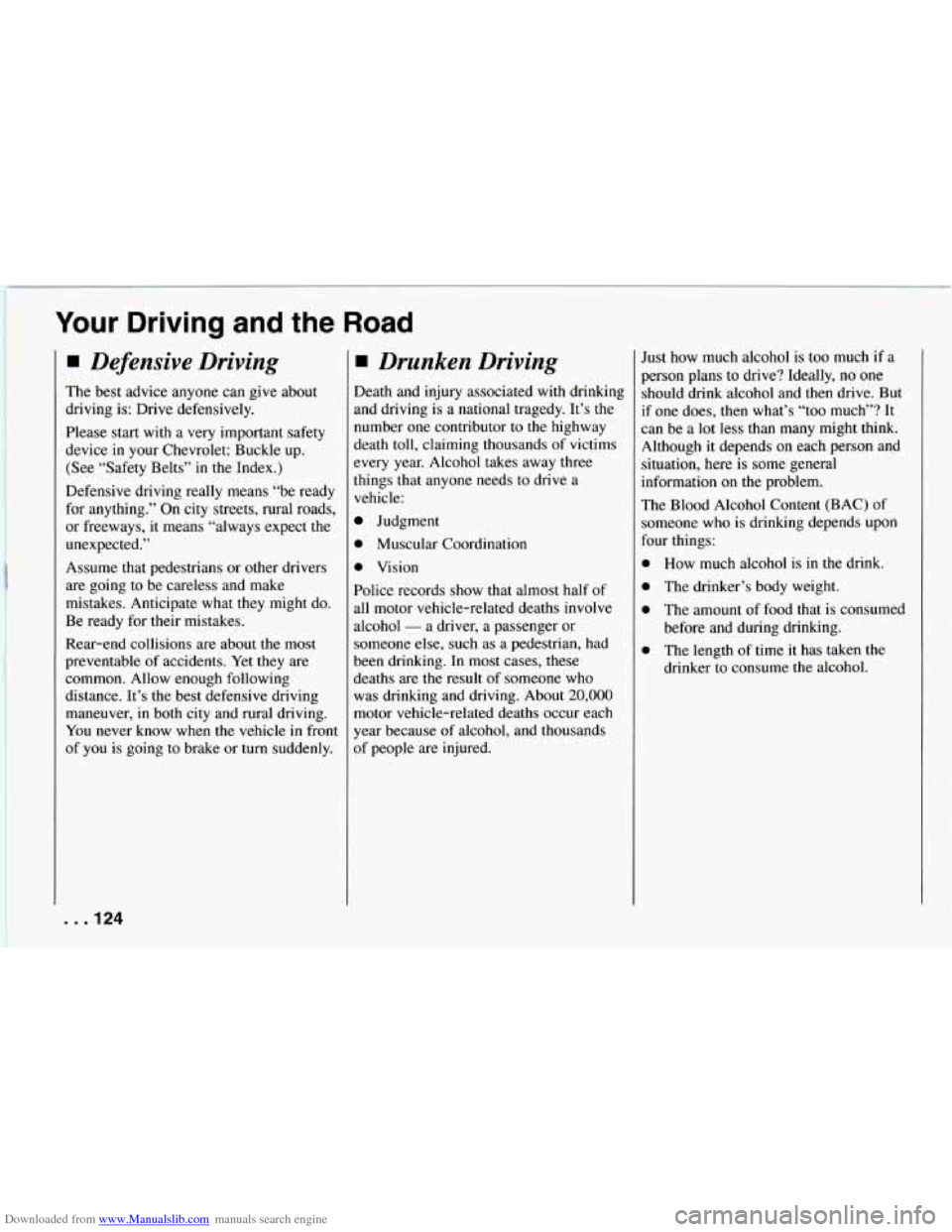
Downloaded from www.Manualslib.com manuals search engine Your Driving and the Road
Defensive Driving
The best advice anyone can give about
driving is: Drive defensively.
Please start with a very important safety
device in your Chevrolet: Buckle up.
(See “Safety Belts” in the Index.)
Defensive driving really means “be ready
for anything.” On city streets, rural roads,
or freeways, it means “always expect the
unexpected.”
Assume that pedestrians or other drivers
are going to be careless and make
mistakes. Anticipate what they might do.
Be ready for their mistakes.
Rear-end collisions are about the most
preventable of accidents. Yet they are
common. Allow enough following
distance. It’s the best defensive driving
maneuver,
in both city and rural driving.
You never know when the vehicle in front
of you is going to brake or
turn suddenly.
Drunken Driving
Death and injury associated with drinking
and driving is a national tragedy. It’s the
number one contributor to the highway
death toll, claiming thousands
of victims
every year. Alcohol takes away three
things that anyone needs to drive a
vehicle:
Judgment
0 Muscular Coordination
0 Vision
Police records show that almost half of
all motor vehicle-related deaths involve
alcohol
- a driver, a passenger or
someone else, such as a pedestrian, had
been drinking. In most cases, these
deaths are the result of someone who
was drinking and driving. About
20,000
motor vehicle-related deaths occur each
year because of alcohol, and thousands
of people are injured. Just
how much alcohol
is too much if a
person plans to drive? Ideally, no one
should drink alcohol and then drive. But
if one does, then what’s “too much”? It
can be a lot less than many might think.
Although it depends on each person and
situation, here is some general
information on the problem.
The Blood Alcohol Content (BAC) of
someone who is drinking depends upon
four things:
How much alcohol is
in the drink.
The drinker’s body weight.
The amount of food that is consumed
before and during drinking.
The length of time
it has taken the
drinker to consume the alcohol.
. . .I24
Page 127 of 292
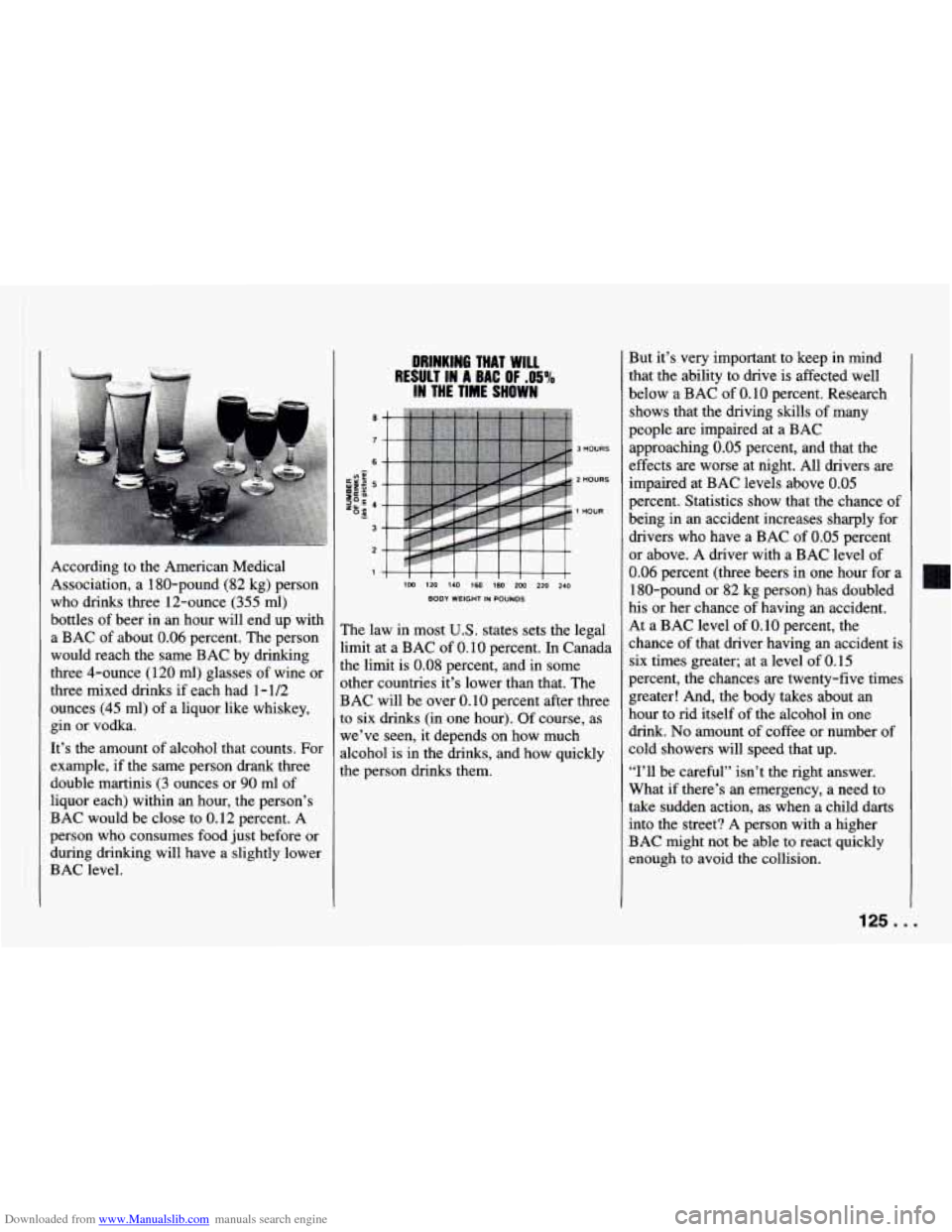
Downloaded from www.Manualslib.com manuals search engine According to the American Medical
Association, a 180-pound (82 kg) person who drinks three 12-ounce
(355 ml)
bottles of beer in an hour will end up with
a BAC of about
0.06 percent. The person
would reach the same BAC by drinking
three 4-ounce (1 20 ml) glasses of wine or
three mixed drinks if each had 1-1/2
ounces
(45 ml) of a liquor like whiskey,
gin or vodka.
It’s the amount of alcohol that counts. For
example, if the same person drank three
double martinis
(3 ounces or 90 ml of
liquor each) within an hour, the person’s
BAC would be close to 0.12 percent. A
person who consumes food just before or
during drinking will have a slightly lower
BAC level.
DRINKING THAT WILL
IN THE TIME SHOWN
RESULT IN A BAC OF .05%
100 120 140 160 1no 200 220 240
BODY WEIGHT IN POUNDS
The law in most U.S. states sets the legal
limit at a BAC
of 0.10 percent. In Canada
the limit is
0.08 percent, and in some
other countries it’s lower than that. The
BAC will be over 0.10 percent after three
to six drinks (in one hour). Of course, as
we’ve seen,
it depends on how much
alcohol is in the drinks, and how quickly
the person drinks them. But it’s
very important to keep in mind
that the ability to drive is affected well
below a BAC of 0.10 percent. Research
shows that the driving skills of many
people
are impaired at a BAC
approaching
0.05 percent, and that the
effects are worse at night. All drivers
are
impaired at BAC levels above 0.05
percent. Statistics show that the chance of
being in an accident increases sharply for
drivers who have a BAC of
0.05 percent
or above. A driver with a BAC level of
0.06 percent (three beers in one hour for a
180-pound or
82 kg person) has doubled
his or her chance of having an accident.
At a BAC level of
0.10 percent, the
chance of that driver having an accident is
six times greater; at a level of 0.15
percent, the chances are twenty-five times
greater! And, the body takes about
an
hour to rid itself of the alcohol in one
drink.
No amount of coffee or number of
cold showers will speed that up.
“I’ll be careful” isn’t the right answer.
What if there’s an emergency, a need to
take sudden action, as when a child darts
into the street? A person with a higher
BAC might not be able to react quickly
enough to avoid the collision.
125 ...
Page 128 of 292
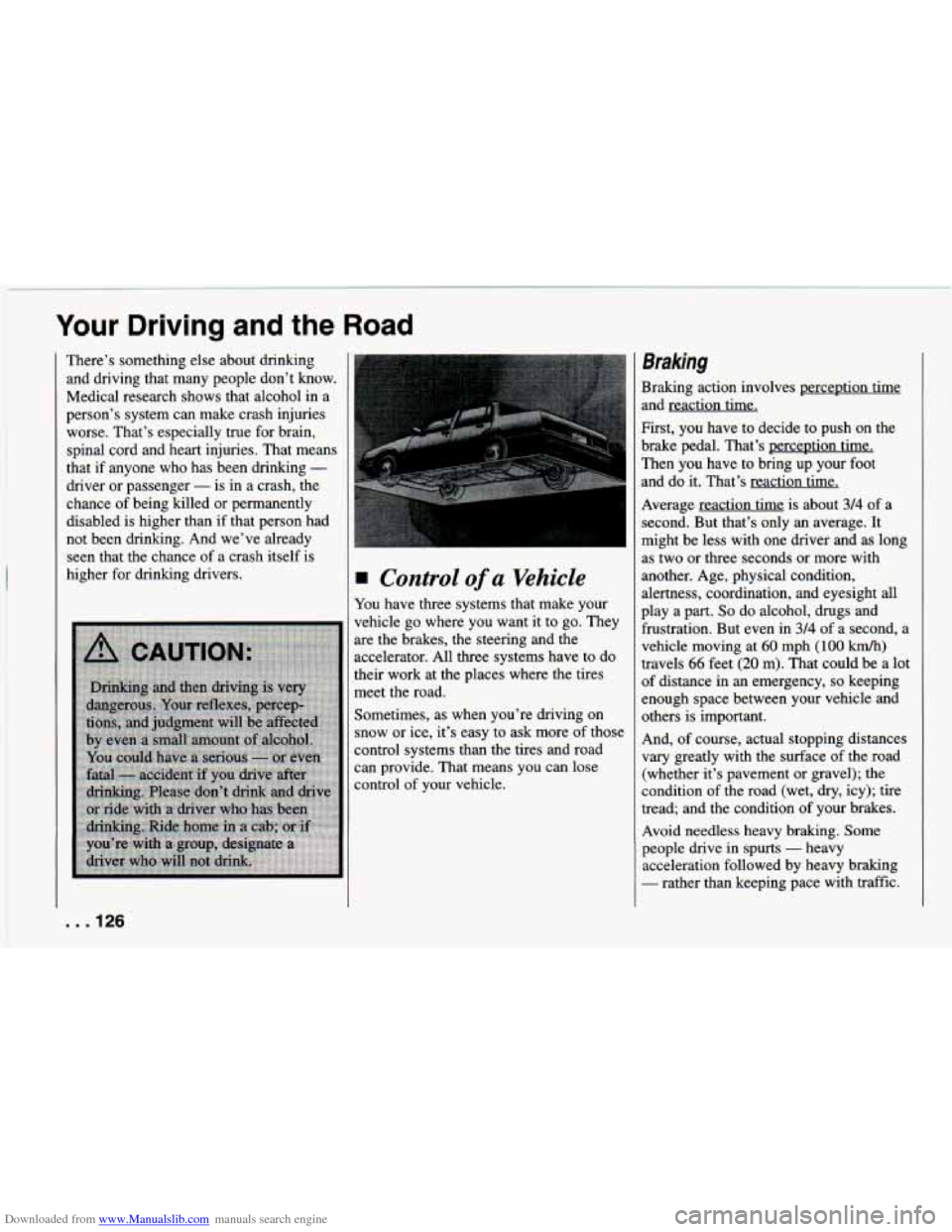
Downloaded from www.Manualslib.com manuals search engine Your Driving and the Road
There’s something else about drinlcing
md driving that many people don’t know.
Medical research shows that alcohol in a
person’s system can make crash injuries
worse. That’s especially true for brain,
spinal card and heart injuries. That means
that if anyone who has been drinking -
driver or passenger - is in a crash, the
chance of being killed or penmmently
disabled is higher than
if that person had
not been &inking. And we’ve already
seen that the chance of a crash itself is
higher far drinkine drivers.
itn~ have three systems that make you
rehide go where you want it to go. They
ue the brakes, the steering and the
um&mtor.
All thee systems have to do
heir work at the places where the tires
neet the road.
Zametimea;, as when you’re driving on
mow or ice, it’s easy to ask more of those
:ontrol systems than the tires and road
can provide. That means you can lose
control of your vehicle.
Br4king
hkblg WtiQIl hVlolV(eB
and reaction time.
First,
you have to decide to push on the
brake pedal. That% perception time,
Then you have to bring up yslur foot
and
do it. That’s
. . ,126
Page 129 of 292
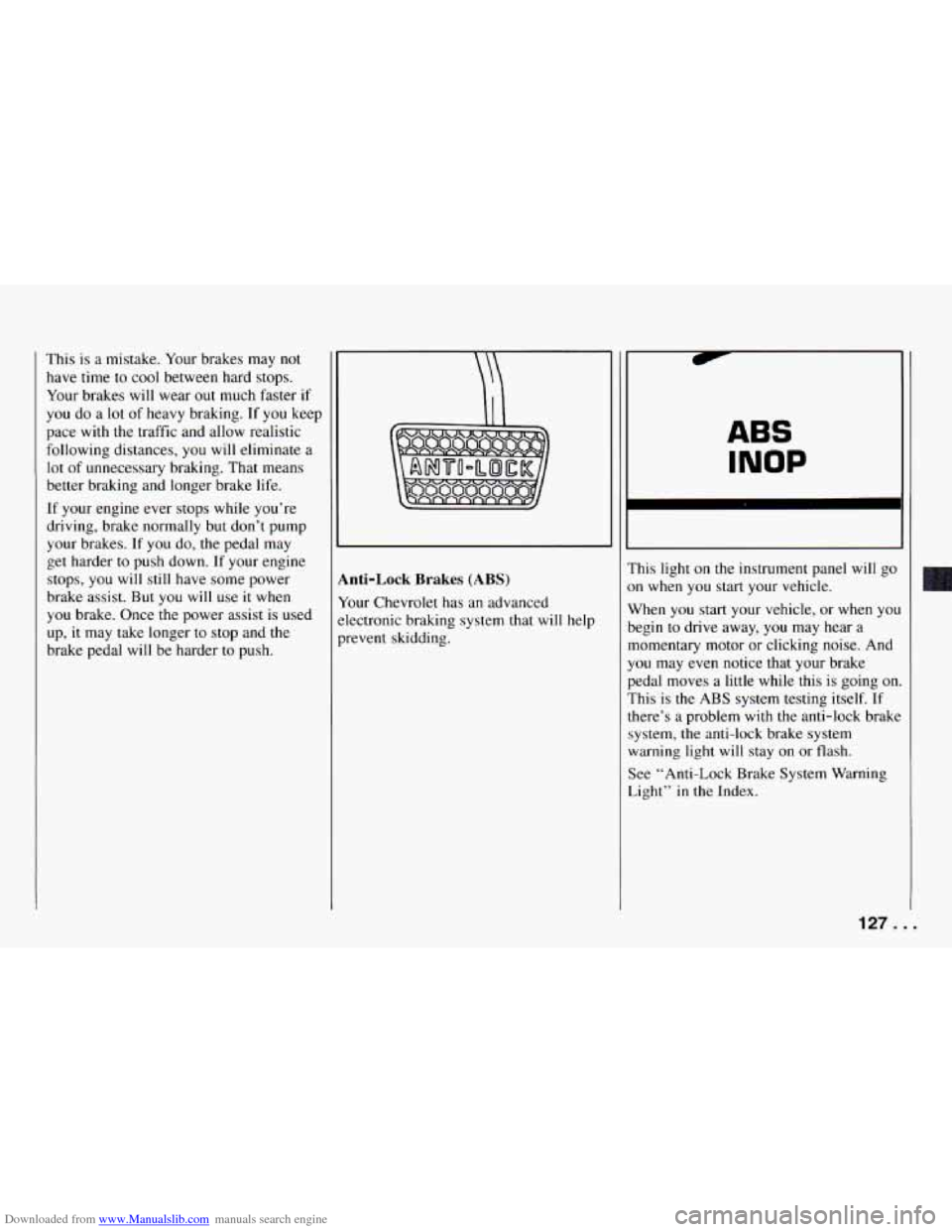
Downloaded from www.Manualslib.com manuals search engine This is a mistake. Your brakes may not
have time to cool between hard stops.
Your brakes will wear out much faster if
you do a lot of heavy braking. If you keep
pace with the traffic and allow realistic
following distances, you will eliminate a
lot of unnecessary braking. That means
better braking and longer brake life.
If your engine ever stops while you’re
driving, brake normally but don’t pump
your brakes. If you
do, the pedal may
get harder to push down. If your engine
stops, you will still have some power
brake assist. But you will use
it when
you brake. Once the power assist is used
up, it may take longer to stop and the
brake pedal
will be harder to push.
inti-Lock Brakes (ABS)
tour Chevrolet has an advanced
klectronic braking system that
will help
- revent sludding.
ABS
INOP
?his light on the instrument panel will go
m when you start your vehicle.
Nhen you start your vehicle, or when yo1
)egin to drive away, you may hear a
nomentary motor or clicking noise. And
’ou may even notice that your brake
bedal moves a little while
this is going on
:his
is the ABS system testing itself. If
here’s a problem with the anti-lock brake
ystem, the anti-lock brake system
varning light will stay
on or flash.
;ee “Anti-Lock Brake System Warning
ight” in the Index.
1
127 ...
Page 130 of 292
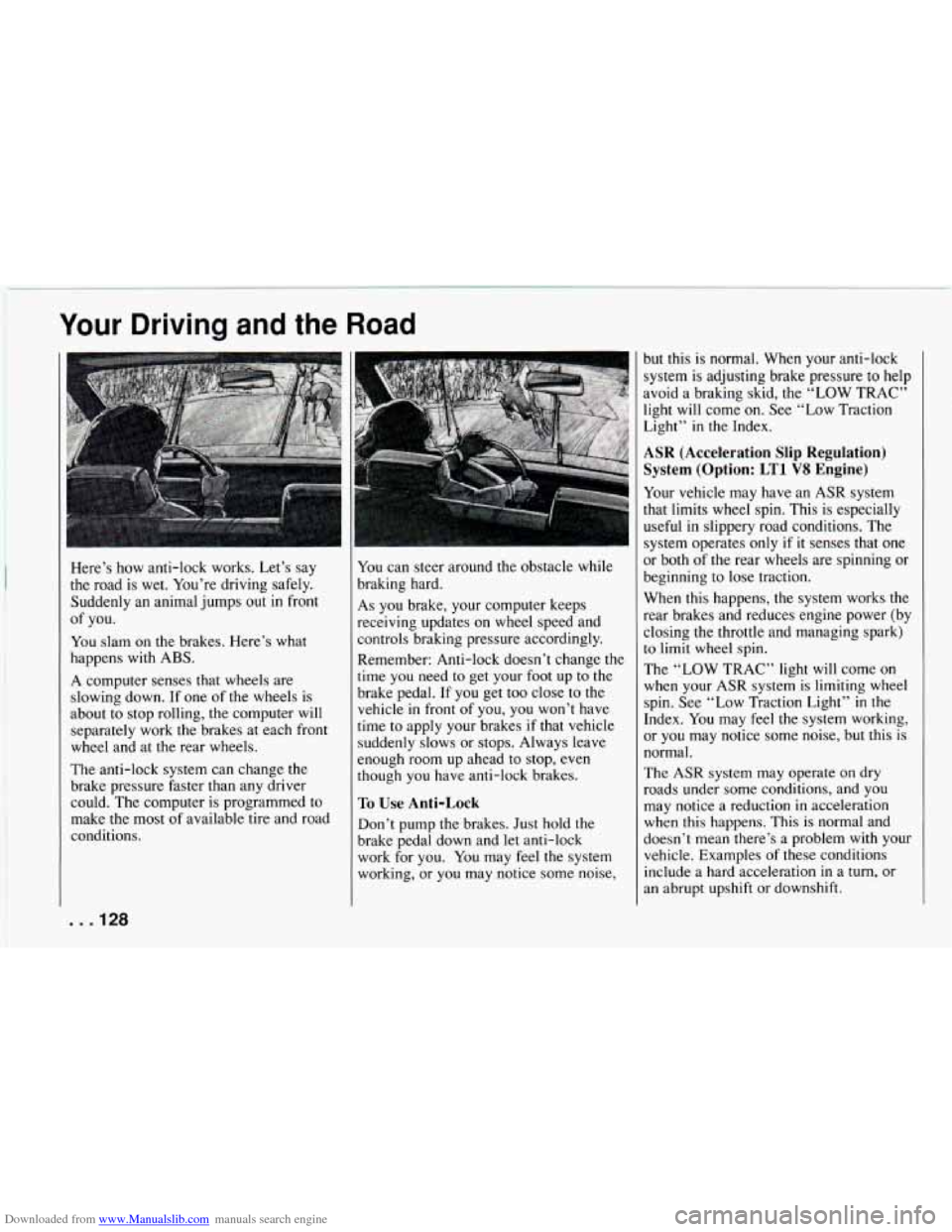
Downloaded from www.Manualslib.com manuals search engine Your Driving and the Road
Here’s how anti-lock works. Let’s say
the road is wet. You’re driving safely. Suddenly an animal jumps out
in front
You slam on the brakes. Here’s what
happens with ABS.
A computer senses that wheels are
slowing down. If one of the wheels is
about to stop rolling, the computer will
separately work the brakes at each front
wheel and at the rear wheels.
The anti-lock system can change the
brake pressure faster than any driver
could. The computer
is programmed to
make the most of available tire and road
conditions.
of you.
You can
steer around the obstacle while
braking hard.
As you brake, your computer keeps
receiving updates on wheel speed and
controls braking pressure accordingly.
Remember: Anti-lock doesn’t change the
time
you need to get your foot up to the
brake pedal.
If you get too close to the
vehicle in front of you,
you won’t have
time to apply your brakes if that vehicle
suddenly slows or stops. Always leave
enough room up ahead to stop,
even
though you have anti-lock brakes.
To Use Anti-Lock
Don’t pump the brakes. Just hold the
brake pedal down and let anti-lock
work for you. You may feel the system
working, or you may notice some noise, but this is normal. When your anti-lock
system
is adjusting brake pressure to help
avoid a braking skid, the
“LOW TRAC”
light will come
on. See “Low Traction
Light”
in the Index.
ASR (Acceleration Slip Regulation) System (Option:
LT1 VS Engine)
Your vehicle may have an ASR system
that limits wheel spin. This
is especially
useful in slippery road conditions. The
system operates only
if it senses that one
or both of the rear wheels are spinning or
beginning
to lose traction.
When this happens, the system works the
rear brakes and reduces engine power (by closing the throttle and managing spark)
to limit wheel spin.
The “LOW TRAC” light will come on
when your
ASR system is limiting wheel
spin. See “Low Traction Light” in the
Index. You may
feel the system working,
or you may notice some noise, but this is
normal.
The
ASR system may operate on dry
roads under some conditions, and you
may notice a reduction
in acceleration
when this happens.
This is normal and
doesn’t mean there’s a problem with
your
vehicle. Examples of these conditions
include a hard acceleration
in a turn, or
an abrupt upshift or downshift.
. . .I28